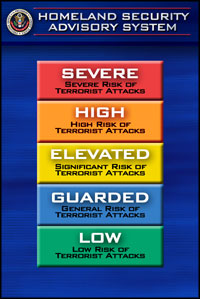Risk Reduction in the event of a Bioterrorism Attack
The United States at all governmental levels ( national, state, county and city) has upgraded protocol and responses to terroristic activities. Guidelines in the event of bio terroristic attacks are being created and stressed to all governmental entities. The guidelines currently developed stress prevention and risk reduction.
| The government has developed Threat Codes to notify the public of possible threats to the safety of U.S. citizens. The various code levels are determined by intelligence from monitoring various terrorist activities world wide and within the U.S. Biological threats are monitored based on reporting guidelines for medical personnel. The Guidelines list diseases that must be immediately reported, when detected in a person or animal.
|
 |
Presently the U.S. Government is using a prevention and treatment program to deal with possible disease outbreaks caused by a biological weapon attack. The government is promoting stockpiling of vaccines for individuals labeled in the High Risk Group. These groups will also start to be monitored for health related problems during the course of a year. The present protocol for the Low Risk Group is to treat the person after they have been infected. Project Bio shield is a government program currently being developed to allow the most advanced vaccines and medicines to be made available to the general public. Medicine and vaccination plan development are topics of debate .
Both risk groups will benefit from guidelines from the Center for Disease Control to upgrade airfiltrations systems in buildings. Most modern system are not sufficient to reduce the effects of biological agents released in a community. Some basic precautions and filter changes to these systems can improve their effectiveness. Most improvements to these systems involve reducing leaks in the older systems and preventing the various types of filters from becoming ineffective. Maintenance techniques, system upgrades and filter requirements are outlined to enhance the overall effectiveness of such systems. Protecting Building Environments.
Click the links below to discuss personal precautions, vaccination programs and risks and treatment methods of specific microbes.
 |
 |
 |
![]()
© 2003 Jay Farmer, J.P. Oehrtman, and Tim Maluvac. All rights reserved, except for the images, which retain their own copyrights.
This site is designed by Jay Farmer, J.P. Oehrtman, and Tim Maluvac for MBI 699.W.
Last modified: August 7, 2003
background courtesy of: http://bt.swmed.edu